Growing potatoes in your home garden is easier than you might think! In this post, I’ll show you everything you need to know in order to get the biggest and best yields.

Potatoes are among the most common crops planted across the world, so why not try growing them in your own garden?
Being able to choose your favorite varieties and reap the delicious rewards is a really fulfilling experience.
In this guide I will walk you through everything you need about how to grow potatoes.
Learn about providing the best soil and fertilizers, how to water them, how to deal with pest or disease issues, and much more.
Potatoes Quick Care Overview
| Scientific name: | Solanum tuberosum |
| Classification: | Vegetable |
| Common names: | Potatoes |
| Hardiness: | Annual |
| Temperature: | 60-70°F |
| Flowers: | Light purple, white, pink, blooms late summer-fall |
| Light: | Full sun |
| Water: | Keep evenly moist, do not overwater |
| Humidity: | Average |
| Fertilizer: | High phosphorus fertilizer spring-summer |
| Soil: | Rich, fertile, well-draining |
| Common pests: | Aphids, potato beetles, flea beetles, eelworms |
Information About Growing Potatoes
Potatoes, or Solanum tuberosum, are part of the Nightshade, or Solanaceae, family. Other edible members of this family include tomatoes, tomatillos, eggplant, and peppers.
In the wild, potatoes are actually perennials originally native to South America. They’re a leafy, herbaceous plant that can reach 3-4’ tall.
But we grow potatoes as annuals worldwide because we have to dig them up in order to eat the yummy tubers.
Different Potato Varieties
There are hundreds of varieties, and several ways to classify a potato. You might find them referred to by name, color, or whether they’re harvested early, mid, or late season.
Perhaps the most useful way to talk about varieties for home gardeners however, is by starch content. Knowing how you want to use them will help you choose the best ones for you.
- High Starch – These mealy, dry potatoes are best baked, boiled, or fried, and include the popular varieties like Russet or Idaho.
- Waxy – Low starch content helps these varieties hold their shape, making them ideal for roasting, soups, and stews. Try red, white, or fingerling types.
- All-Purpose – The medium starch content makes them great for any use. Blue, yellow, and all types of new potatoes fall in this category.
How Do Potatoes Grow?
It’s probably no surprise to you that potato tubers grow under the ground. But, you may not know that they actually form along the central vine, instead of at the end of the roots.
As the vine gets taller, gardeners mound or ‘hill’ soil around it. The more it’s buried, the more tubers will form, increasing your bounty.
Related Post: Delicious Healthy Potato Soup Recipe
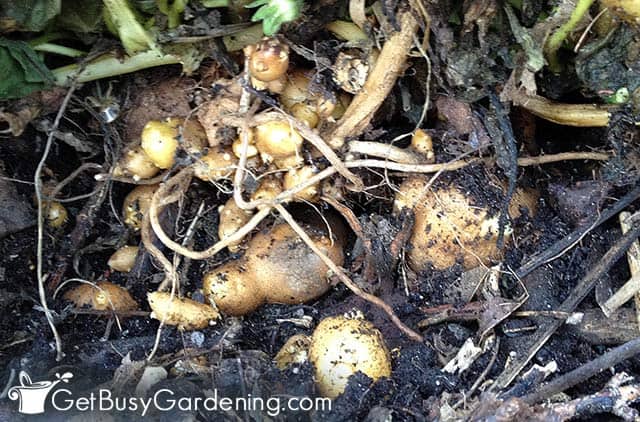
How To Grow Potatoes
Before we get into caring for potato plants, first you’ll need to know where and how to plant them. Choosing the right spot is an important step for a successful yield.
Where To Grow Potatoes
It’s best to grow potatoes outdoors in full sun in a fertile, loamy soil that drains well. You can plant them in raised beds, garden plots, or even large containers.
They perform them best in rows spaced every 3’. Each plant will need at least 1’ of space from its neighbor in order to produce good-sized tubers.
How To Plant Potatoes
Potato plants sprout from the eyes of mature tubers called seed potatoes, which you can find at your local nursery in the spring or online.
Cut your starting spud into 2” chunks that include an eye or two. Then allow it to cure (dry) at room temperature for a few days before planting.
Dig a trench at least 6” deep, and space each chunk 12” apart with the eyes facing up. Get my full step-by-step instructions for how to plant them here.
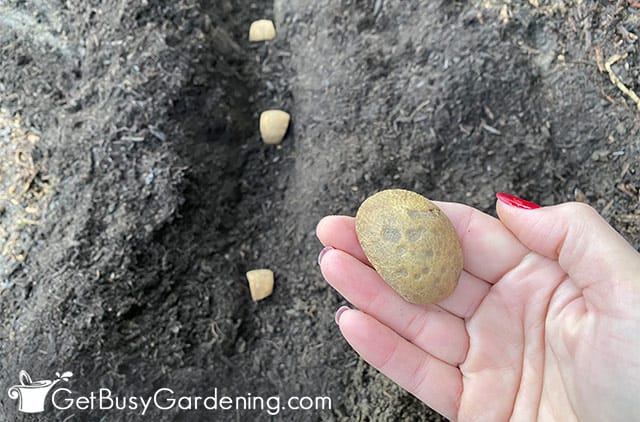
Potato Plant Care & Growing Instructions
Once your potato plants begin to grow, providing the best care through the season will increase your odds of a good yield. These tips will help you give them everything they need.
Sunlight
Potato plants thrive in full sun, ideally between 6-8 hours a day. They can handle partial shade, but they won’t perform as well.
If they get too much shade, they either won’t produce any tubers at all, or the ones that do form will be very small.
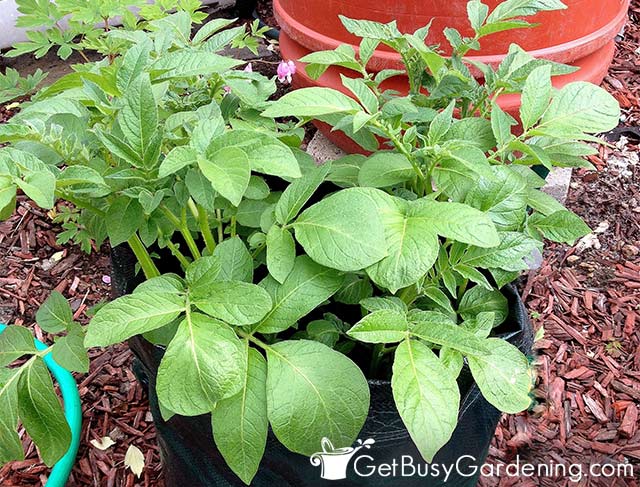
Water
They need consistent moisture to develop good sized tubers, 1-2” per week is ideal. If they’re not getting enough rainfall, check on them every few days, and water by hand if necessary.
Infrequent, inconsistent, or lack of water can cause misshapen, deformed, or small potatoes. An inexpensive moisture gauge will help you get it right.
During flowering they’ll need more, so keep a closer eye on them. After that, the foliage will begin to yellow and die back. At that point, stop watering entirely.
Related Post: How To Water A Vegetable Garden, The Right Way!
Temperature
Potatoes grow best when the ground temperature ranges between 60-70°F. Tuber formation may slow down when it exceeds 80°F.
Use a soil thermometer to measure it, and add mulch around the stems to keep the roots and potatoes cool if it gets too warm.
They do not like the cold, so wait until the soil is 45°F or warmer to start them, or they may end up rotting.
Fertilizer
The best fertilizer for growing potato plants is a natural formula that’s high in phosphorus but low in nitrogen. Too much nitrogen will give you beautiful green leafy foliage, but tiny or poorly developed tubers.
Using a quality compost, liquid fish emulsion, worm castings, or compost tea is also a great way to boost nutrients.
Begin fertilizing your potatoes once the plants start growing, and continue monthly until the foliage starts to die back in late summer or early fall.
Related Post: How & When To Fertilize Your Vegetable Garden

Soil
Potatoes will thrive in a slightly acidic, fertile soil with a pH of 5-6.5. It should be loose and well-draining, but not sandy or rocky.
Amending your garden beds with compost is a good first step. But you can also check the pH using a probe tool, and add an acidifier or slow release acidic fertilizer granules if necessary.
As they get larger, it’s important to always keep soil mounded over the forming tubers. Otherwise the sunlight will cause them to turn green and become inedible.
Pruning
Pruning at certain stages in a potato plant’s growing cycle can help improve the size of the tubers.
When the first flowers form, pinch them off to focus resources on tuber formation. Then, once flowering has finished and the plant has died back, cut the stem down to 1” above the ground.
Pest Control Tips
Unfortunately potato plants are susceptible to many pests. Aphids, potato beetles, flea beetles, and eelworms are just a few of the most common ones.
Hand picking is a great way to remove any visible large insects you see. But other aids include sprinkling diatomaceous earth around the plant to kill off beetles. Sticky yellow traps can help prevent and control any flying bugs.
You should also be checking the underside of the leaves for orange egg sacs. Quickly remove them to head off potato beetle outbreaks.
If necessary, you can use an organic insecticidal soap to kill insects on contact, and to wash any you can’t see off of the leaves.
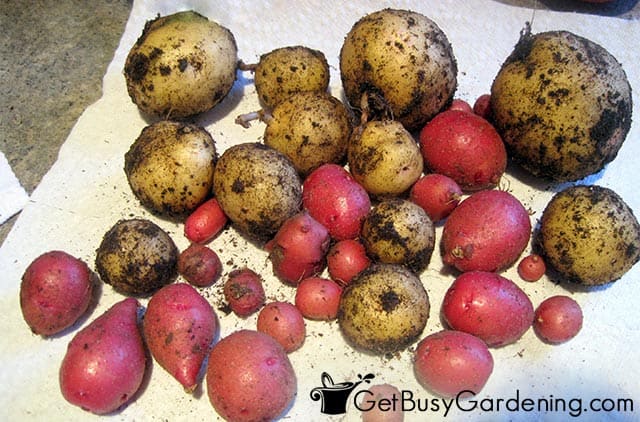
Disease Control Tips
There are a variety of fungal diseases that can affect your potato plant’s growth and production.
Early or late season blight will yellow and darken the foliage before rotting the tubers. Verticillium wilt will kill the plant before flowering, and potato scab creates unsightly brown patches on your tubers, though they’re often still edible.
The best prevention method is to buy certified disease-free seed potatoes from reliable nurseries or growers.
You should also rotate your crop every year to a different area of your garden, and avoid growing potatoes in alkaline soil, which can encourage scab to form.
Tips For Harvesting Potatoes
You’ll know it’s time to dig them up when the plant has finished flowering and is completely wilted. Cut away the dead foliage, and gently start digging in a diameter 1’ away from the stem.
As you begin to unearth the tubers, remove them with your hands to prevent cutting or damaging them with your shovel. Inspect each one for rot, and transfer any you wish to store long term to a dry, dark, cool location.
Get step by step instruction on exactly when and how to dig them up in my detailed harvesting guide.
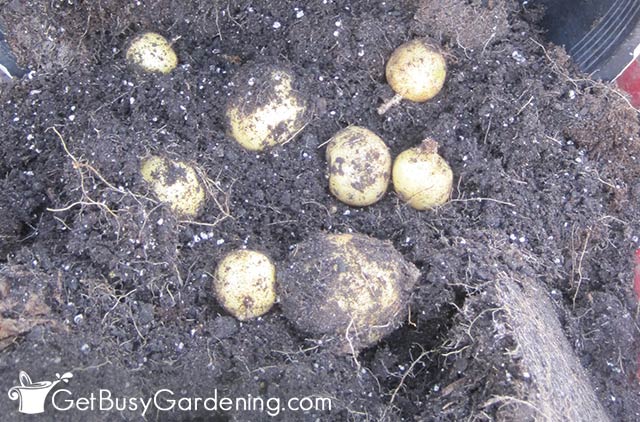
Troubleshooting Common Problems
Learning to grow a new crop can always be a challenge. Here are my best tips for common potato plant care problems so you can get yours back in good health, or be better prepared next year.
Very Few Or No Potatoes
When your potato plant is all leaves and no tubers it’s likely an issue of soil quality, lack of sun, or too much nitrogen.
They need fertile soil and full sun to produce their best. If there’s too much nitrogen, or not enough phosphorus, they’ll put on lots of leafy foliage instead.
Potatoes Are Small
There are a few reasons why your potatoes are small. Lack of sunlight is a common issue, as are pests, disease, and improper fertilizing. Or they may be overcrowded and struggling to get adequate moisture and nutrients.
Heat waves and too little water are also common causes. Make sure the soil is consistently, evenly moist, and when temps are above 80°F, cover them with a layer of mulch to help keep them cool.
Plant Is Dying
If your potato plant is dying it could be heat, harsh sun, strong winds, or lack of water.
But it could also be an issue of wilt or disease. Choose a resistant variety to help prevent these issues to begin with.
Once you’re facing it though, treat the plants with a natural fungicide, or remove and destroy the affected one to prevent it from spreading to others.
Related Post: How To Can Potatoes
FAQs About Growing Potatoes
I’ve answered several of the most commonly asked questions about growing potatoes here. If yours isn’t listed, please add it to the comments section below.
Can you grow potatoes from a potato?
Yes you can grow potatoes from a potato, it’s the most common way in fact. Though using the ones from the grocery store can work, it’s best to buy seed potatoes in order to have the best success.
How long does it take potatoes to grow?
How long it takes potatoes to grow depends on the variety, but most are ready for harvest within 3-4 months, when given the proper care.
How many potatoes do you get from one plant?
How many potatoes you get from one plant will depend on the variety, growing conditions, and care. When given the ideal environment, each plant can produce between 5-10 tubers, on average.
Growing a potato from start to finish is rewarding and fun. When you’re ready to try it in your garden, these care tips will help you keep them thriving.
More About Vegetable Gardening
- How To Grow Garlic
- How To Grow Cauliflower
- How To Grow Your Own Sprouts At Home
- How To Grow Cucumbers
- How To Grow Brussels Sprouts
- How To Grow Onions
Share your tips for how to grow potatoes in the comments section below.

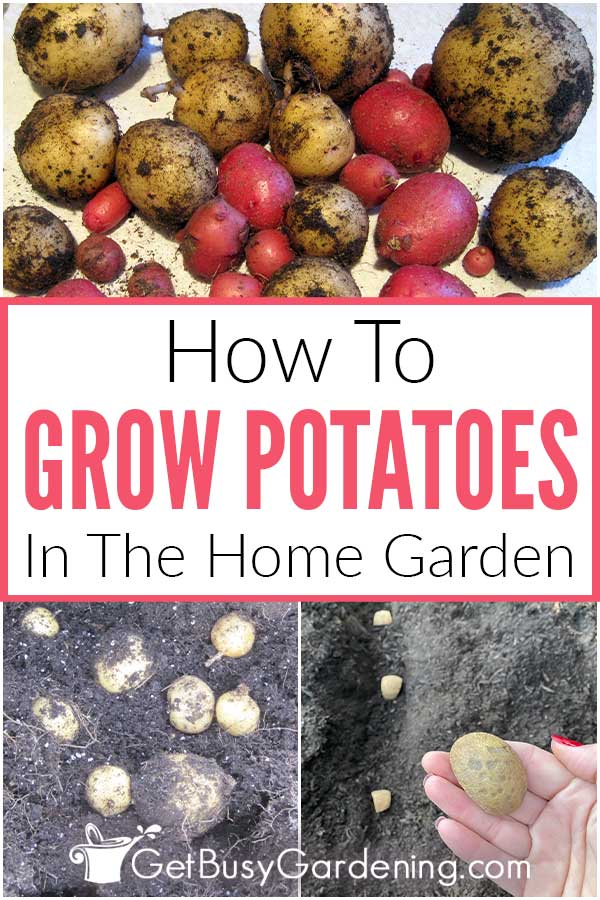
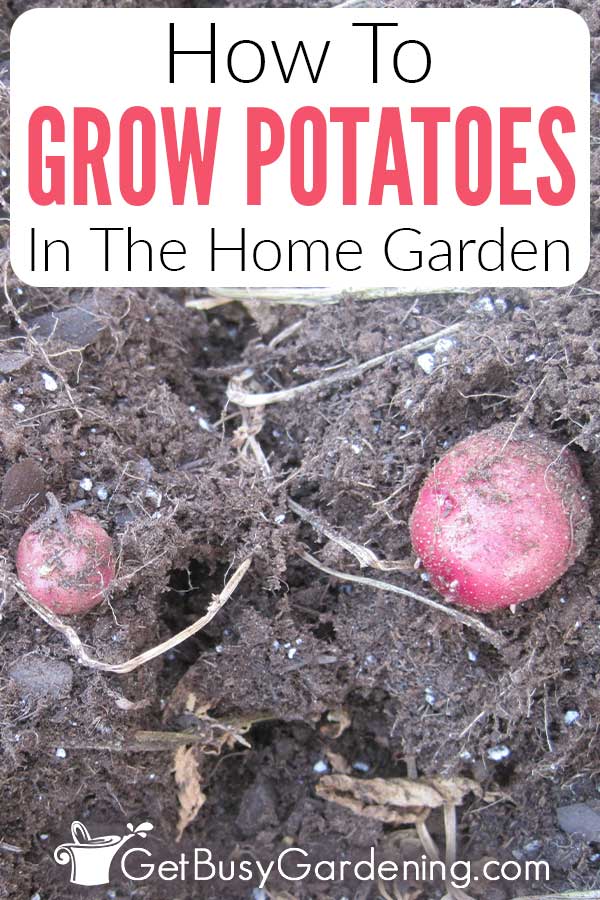


Leave a Reply